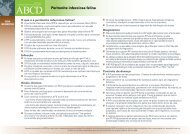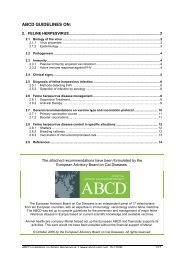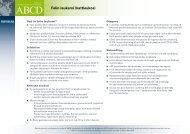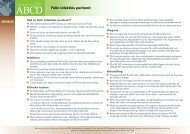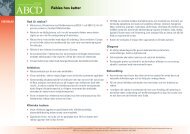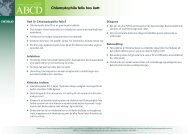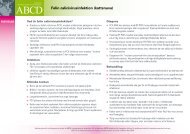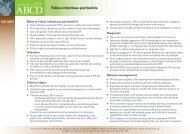Feline calicivirus infection - The European Advisory Board on Cat ...
Feline calicivirus infection - The European Advisory Board on Cat ...
Feline calicivirus infection - The European Advisory Board on Cat ...
You also want an ePaper? Increase the reach of your titles
YUMPU automatically turns print PDFs into web optimized ePapers that Google loves.
field study, 20% of kittens at <strong>on</strong>ly six weeks of age had no detectable antibodies against awidely used vaccine strain (Daws<strong>on</strong> et al. 2001).Active immune resp<strong>on</strong>seVirus neutralising antibodies (VNA) appear by approximately seven days post <str<strong>on</strong>g>infecti<strong>on</strong></str<strong>on</strong>g>(Kahn et al., 1975). In general, antibody titres are higher than for FHV <str<strong>on</strong>g>infecti<strong>on</strong></str<strong>on</strong>g> and theirlevels correlate well with protecti<strong>on</strong> against homologous challenge (Povey & Ingersoll, 1975).<str<strong>on</strong>g>The</str<strong>on</strong>g>re is a c<strong>on</strong>siderable degree of antigenic variability am<strong>on</strong>gst FCV strains, but it wasc<strong>on</strong>cluded from studies of in vitro cross-reactivity that FCVs bel<strong>on</strong>g to a single serotype(Povey, 1974). Prior <str<strong>on</strong>g>infecti<strong>on</strong></str<strong>on</strong>g> with <strong>on</strong>e strain can significantly reduce the acute clinical signsup<strong>on</strong> exposure to a heterologous strain, and in some cases oral shedding may be reduced(Povey & Ingersoll, 1975; Knowles et al., 1991). In general, the level of heterologousprotecti<strong>on</strong> will depend <strong>on</strong> the virus strains involved.<strong>Cat</strong>s may be protected also in the absence of detectable VNA (Knowles et al., 1991; Poulet etal., 2005), suggesting a role for other immune mechanisms: indeed, cellular resp<strong>on</strong>ses havebeen dem<strong>on</strong>strated in vaccinated cats (Tham & Studdert, 1987). Also, FCV-specific IgG andIgA antibodies have been dem<strong>on</strong>strated in the saliva during the course of <str<strong>on</strong>g>infecti<strong>on</strong></str<strong>on</strong>g> (Knowleset al., 1991), although their significance in protecti<strong>on</strong> is unknown.Clinical signsFCV <str<strong>on</strong>g>infecti<strong>on</strong></str<strong>on</strong>g> can cause acute oral and upper respiratory signs but also has been associatedwith chr<strong>on</strong>ic stomatitis, which may be immune-mediated. Recently, a new syndrome, the“virulent systemic feline <str<strong>on</strong>g>calicivirus</str<strong>on</strong>g> (VS-FCV) disease” has been described.Acute oral and upper respiratory tract diseaseClinical findings may differ, depending <strong>on</strong> the virulence of the FCV strain c<strong>on</strong>cerned, <strong>on</strong> theage of the affected cats and <strong>on</strong> husbandry factors. While in some cases <str<strong>on</strong>g>infecti<strong>on</strong></str<strong>on</strong>g> issubclinical, in many others, there is a typical syndrome of lingual ulcerati<strong>on</strong> and a relativelymild acute respiratory disease. More severe signs can resemble the respiratory disease causedby FHV-1.Acute oral and upper respiratory disease signs are mainly seen in kittens. <str<strong>on</strong>g>The</str<strong>on</strong>g> incubati<strong>on</strong>period is 2 to 10 days (Hurley and Sykes, 2003). Oral ulcerati<strong>on</strong>s, sneezing and serous nasaldischarge are the main signs (Gaskell et al., 2006). Fever is also observed. Anorexia,sometimes accompanied by hypersalivati<strong>on</strong> due to oral erosi<strong>on</strong>s - located mainly <strong>on</strong> thet<strong>on</strong>gue - are usually much more prominent than the signs of rhinitis. <str<strong>on</strong>g>The</str<strong>on</strong>g>y usually resolveafter several days. In some severe cases, pneum<strong>on</strong>ia, manifested by dyspnoea, coughing, feverand depressi<strong>on</strong> can occur, particularly in young kittens.Chr<strong>on</strong>ic stomatitisFCV can be isolated from nearly all cats with the chr<strong>on</strong>ic lymphoplasmacyticgingivitis/stomatitis complex, and many cats test positive by PCR (Dowers 2010, Belgard2010). It has been suggested to be an immune-mediated reacti<strong>on</strong> to FCV (and potentiallyother) oral antigens and is characterised by a severe proliferative/ulcerative faucitis. However,the disease has not been reproduced experimentally (Knowles et al., 1991), and the exact role



